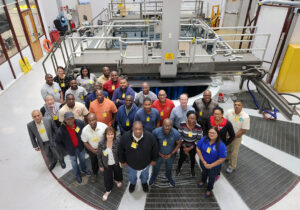
In May, the Center for Nuclear Security Science and Policy Initiatives (NSSPI) worked with the International Atomic Energy Agency (IAEA) to conduct a School for Radiation Emergency Management (SREM) for members of the Caribbean Community (CARICOM) on the campus of Texas A&M University. The SREM is designed for professionals who are responsible for managing and coordinating nuclear and radiological emergency preparedness and response. Participants included relevant professionals from Antigua and Barbuda, Bahamas, Barbados, Grenada, Guyana, Jamaica, St. Lucia, St. Vincent and the Grenadines, and Trinidad and Tobago.
“Though the number of radiation sources in Antigua and Barbuda is few and not of great concern at the moment,” explained participant Anderson Tuitt of the island nation’s National Office of Disaster Services, “it is imperative that we are prepared for any eventualities. Persons dealing with radiation and responding to radiological emergencies could be fearful at times but with the right training and legislative framework in place, such could put minds at ease and allow first responders to respond safely.”




The SREM was led by Muzna Assi and Loreto Villanueva from the IAEA Incident and Emergency Centre along with Lead Expert Raul dos Santos of the Brazilian National Nuclear Energy Commission (CNEN). They were joined by IAEA expert Cris Ardoin of the National Centre for Radiation Science (NCRS) in New Zealand and local experts NSSPI Deputy Director Craig Marianno, William “Chris” Moore of the Texas Department of State Health Services, Linda Morris of the Texas Low-Level Radioactive Waste Disposal Compact Commission, and Latha Vasudevan and Michael Martin from Texas A&M Environmental Health and Safety. Participants gained a comprehensive understanding of emergency preparedness and response for nuclear and radiological emergencies, which included lectures, group activities, demonstrations, practical sessions, site visits, and a field exercise.

According to Marlon Buchanan of the Jamaica Fire Brigade, “The experts disseminated lectures that were both theoretical and practical in nature. Also, they taught us real-life emergencies that they were involved in and how they managed different types of incidents.”

The two-week training began with an overview of past radiological emergencies and radiation detection devices, which included a working session in which participants were able to practice using different types of devices. They then covered the basics of responding to a radiological emergency and participated in various group and role-playing activities. They toured the TRIGA research reactor at the Texas A&M Nuclear Engineering and Science Center, the National Center for Electron Beam Research, and the Texas A&M Environmental Health and Safety facility, where they were able to try on the various levels of personal protective equipment used during radiological emergencies. The second week focused on more in-depth discussions of emergency response, including communication with the public, and culminated in a full day of practical activities. During this week, they toured the Brazos County Emergency Operations Center, completed a media exercise at the Texas A&M Engineering Extension Agency (TEEX) Emergency Operations Training Center, and participated in a source recovery field exercise at the TEEX Disaster City Facility led by Marianno and a group of NSSPI students.

Tuitt explained that the training was “timely and presented opportunities for persons to look at their various countries and their legal frameworks–or lack thereof–and ensure that we are all in a position to safely deal with radiation and radiological emergencies.”
The SREM conducted at Texas A&M is part of a series of IAEA Technical Cooperation projects aimed at supporting the advance of radiation safety and regulatory infrastructure in the CARICOM. A previous SREM for the CARICOM was conducted at Texas A&M in 2018 and in December 2022 NSSPI organized a train-the-trainer workshop that provided hands-on training in radiation detection for radiation safety professionals from the region. These activities are helping prepare the small nations to respond to big incidents and building a community of skilled professionals in the region.

Buchanan echoed, “Howard Ruff states, ‘It wasn’t raining when Noah built the Ark.’ I state that to say that Jamaica may not have had any major radiological or nuclear incidents. Nonetheless, the nation is far more prepared to manage incidents of this nature. The School of Radiation Emergency Management has equipped me and my colleagues with the skills and knowledge to respond efficiently and effectively if the need arises.”